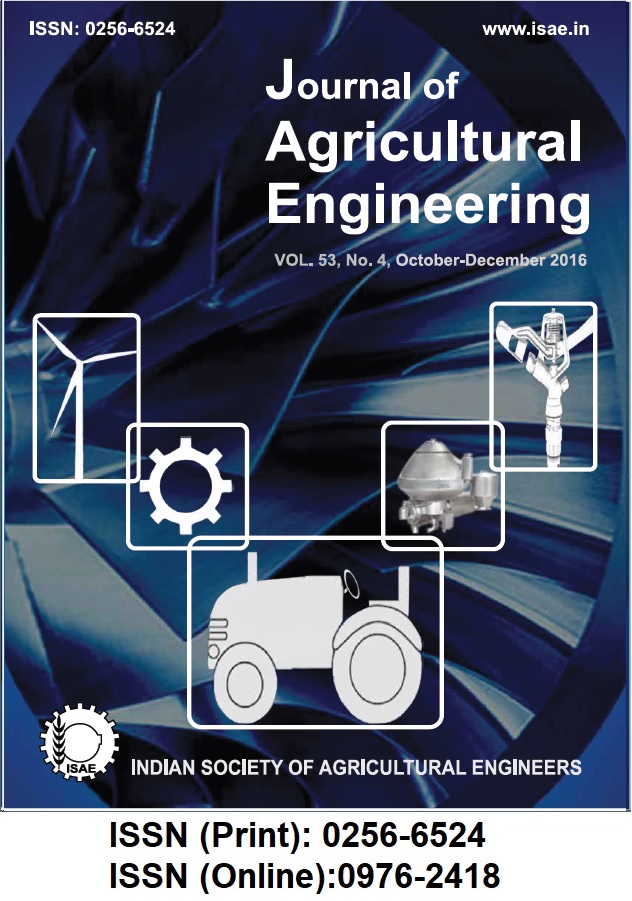Impact of Wheat Cultivation under Conservation Practices on Resourceuse Efficiency in Karnal and Kurukshetra Districts of Haryana
DOI:
https://doi.org/10.52151/jae2016534.1610Keywords:
Allocative efficiency, technical efficiency, economic efficiencyAbstract
A study was conducted to examine the resource-use efficiency of wheat cultivation under conservation and conventional methods in Haryana. A sample of 120 wheat producers was surveyed in four villages in the study area during 2012-13.The allocative efficiency of labour and irrigation in wheat cultivation using zero seed drill indicated over-use of these resources. The allocative efficiency of wheat cultivation under conventional tillage system showed that labour-use efficiency was 0.83 and fertilizer-use efficiency was 0.53. The allocative efficiency of wheat cultivation with rotavator showed that fertilizer-use and irrigation-use efficiency were over-used. The estimated mean technical efficiency of wheat farms under zero-tillage was 96% in their use of inputs. The technical efficiency of cultivation by rotavator was found to be 95%, indicating that average return of wheat could be increased by 5% by adopting the technology more scientifically. The economic efficiency measure was 62%, 52% and 34% in zero, rotavator and conventional tillage, respectively, indicating that there was scope to increase the returns by 38%, 48% and 64%, respectively, with optimum resource allocation. The study revealed that the farmers were inefficient in using their resources.
References
Aigner D; Lovel C A K; Schmidt P. 1997. Formulation and estimation of stochastic frontier production function models. J. Econ., 6(1), 21-37.
Ali M; Sattar M. 2010. Sowing date effect on yield of different wheat varieties. J. Agric. Res., 48(2), 157-162.
Coelli T. 1996. A Guide to DEAP Version 2.1: A Data Development Analysis (Computer) program. Centre for Efficiency and Productivity Analysis, University of New England.
Gupta R K; Seth A. 2007. A review of resource conserving technologies for sustainable management of the rice wheat systems of the Indo-Gangetic Plains. Crop Prot., 26(3), 436-447.
Kachroo J; Sharma A; Kachroo D. 2010. Technical efficiency of dryland and irrigated based wheat based on stochastic model. Agric. Econ. Res. Rev., 23, 383-390.
Irfaq M; Mumhamma T; Amin M; Jabbar A. 2005. Performance of yield and other agronomic characteristics of four wheat genotypes under natural heat stress. Int. J. Bot.,1(2), 124-127.
Sharma R C. 1992. Duration of the vegetative and reproductive period in relation to yield performance of spring wheat. Eur. J. Agron., 1, 133-137.
Singh N P; Singh R P; Kumar R; Vashist A K; Khan B F; Varghese N. 2011. Adoption of resource conservation technologies in Indo-Gangetic plains of India: scouting for profitability and efficiency. Agric. Econ. Res. Rev., 24, 15-24.
Timmer C P. 1971. Using a probalistic frontier function to measure technical efficiency. J. Political Econ., 79, 776-794.
Tripathi R S; Raju R; Thimmappa K. 2013. Impact of zero-tillage on economics of wheat production in Haryana. Agric. Econ. Res. Rev., 26(1), 101-108.
Tien D; K Zenaida M; Sumalde; Olivier V; McKinley D; Yolanda T; Garcia Amelia L. 2011. Technical efficiency of resource- conserving technologies in rice-wheat systems: the case of Bihar andeastern Uttar Pradesh in India. Agric. Econ. Res. Rev., 24(2), 5-8.














